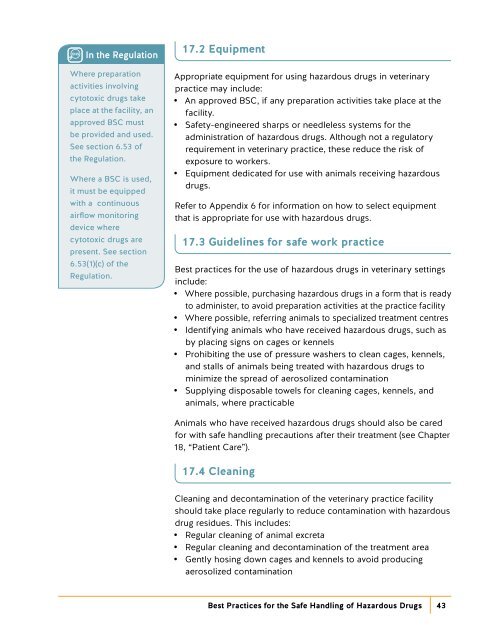Safe Handling of Hazardous Drugs
YU0w0
YU0w0
Create successful ePaper yourself
Turn your PDF publications into a flip-book with our unique Google optimized e-Paper software.
In the Regulation<br />
Where preparation<br />
activities involving<br />
cytotoxic drugs take<br />
place at the facility, an<br />
approved BSC must<br />
be provided and used.<br />
See section 6.53 <strong>of</strong><br />
the Regulation.<br />
Where a BSC is used,<br />
it must be equipped<br />
with a continuous<br />
airflow monitoring<br />
device where<br />
cytotoxic drugs are<br />
present. See section<br />
6.53(1)(c) <strong>of</strong> the<br />
Regulation.<br />
17.2 Equipment<br />
Appropriate equipment for using hazardous drugs in veterinary<br />
practice may include:<br />
••<br />
An approved BSC, if any preparation activities take place at the<br />
facility.<br />
••<br />
<strong>Safe</strong>ty-engineered sharps or needleless systems for the<br />
administration <strong>of</strong> hazardous drugs. Although not a regulatory<br />
requirement in veterinary practice, these reduce the risk <strong>of</strong><br />
exposure to workers.<br />
••<br />
Equipment dedicated for use with animals receiving hazardous<br />
drugs.<br />
Refer to Appendix 6 for information on how to select equipment<br />
that is appropriate for use with hazardous drugs.<br />
17.3 Guidelines for safe work practice<br />
Best practices for the use <strong>of</strong> hazardous drugs in veterinary settings<br />
include:<br />
••<br />
Where possible, purchasing hazardous drugs in a form that is ready<br />
to administer, to avoid preparation activities at the practice facility<br />
••<br />
Where possible, referring animals to specialized treatment centres<br />
••<br />
Identifying animals who have received hazardous drugs, such as<br />
by placing signs on cages or kennels<br />
••<br />
Prohibiting the use <strong>of</strong> pressure washers to clean cages, kennels,<br />
and stalls <strong>of</strong> animals being treated with hazardous drugs to<br />
minimize the spread <strong>of</strong> aerosolized contamination<br />
••<br />
Supplying disposable towels for cleaning cages, kennels, and<br />
animals, where practicable<br />
Animals who have received hazardous drugs should also be cared<br />
for with safe handling precautions after their treatment (see Chapter<br />
18, “Patient Care”).<br />
17.4 Cleaning<br />
Cleaning and decontamination <strong>of</strong> the veterinary practice facility<br />
should take place regularly to reduce contamination with hazardous<br />
drug residues. This includes:<br />
••<br />
Regular cleaning <strong>of</strong> animal excreta<br />
••<br />
Regular cleaning and decontamination <strong>of</strong> the treatment area<br />
••<br />
Gently hosing down cages and kennels to avoid producing<br />
aerosolized contamination<br />
Best Practices for the <strong>Safe</strong> <strong>Handling</strong> <strong>of</strong> <strong>Hazardous</strong> <strong>Drugs</strong> 43


